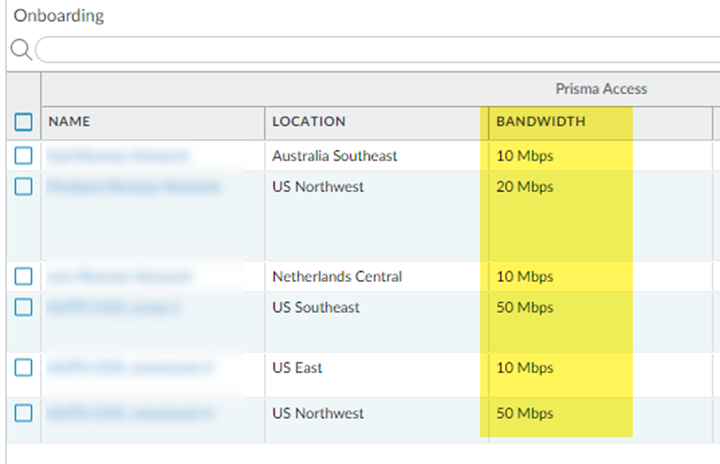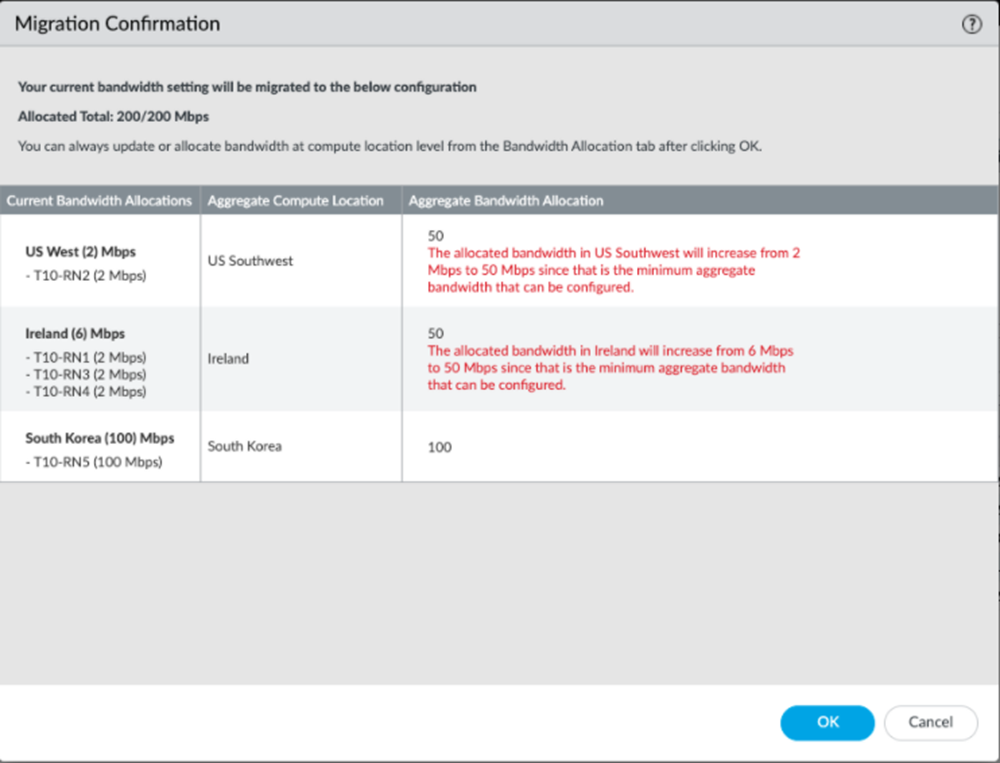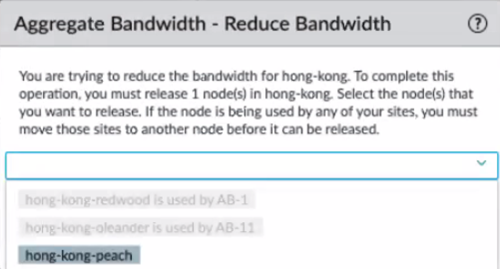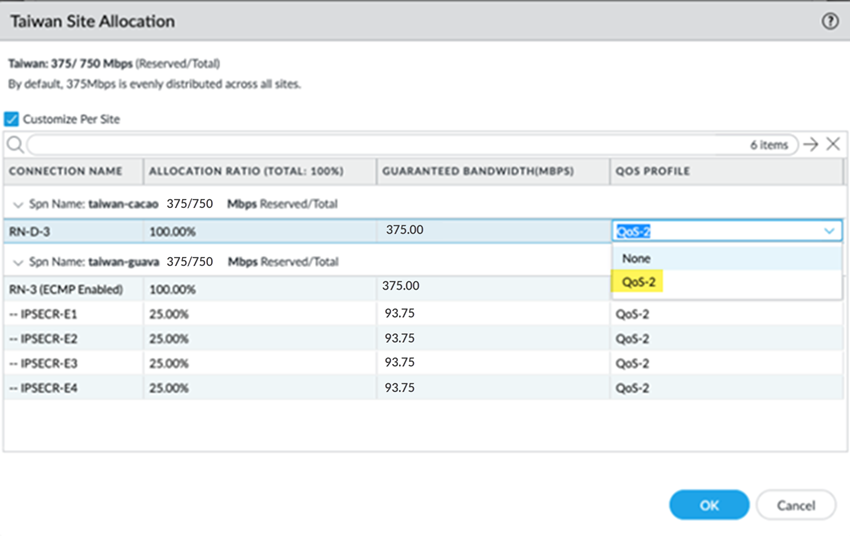Prisma Access
Plan Your Migration to the New Model
Table of Contents
Expand All
|
Collapse All
Prisma Access Docs
-
- 6.1 Preferred and Innovation
- 6.0 Preferred and Innovation
- 5.2 Preferred and Innovation
- 5.1 Preferred and Innovation
- 5.0 Preferred and Innovation
- 4.2 Preferred
- 4.1 Preferred
- 4.0 Preferred
- 3.2 Preferred and Innovation
- 3.1 Preferred and Innovation
- 3.0 Preferred and Innovation
- 2.2 Preferred
-
-
- 4.0 & Later
- Prisma Access China
-
-
Plan Your Migration to the New Model
Learn how to plan from a deployment that allocates bandwidth by Prisma Access location to
one that aggregates bandwidth by compute location.
| Where Can I Use This? | What Do I Need? |
|---|---|
|
|
Bandwidth for new Prisma Access remote network deployments are allocated at
an aggregate level per compute location, also known as the aggregate bandwidth
model. Allocating bandwidth at a compute location level offers you more
flexibility in allocating your licensed remote network bandwidth, because Prisma Access
dynamically allocates the bandwidth for each location based on load or demand.
If you have an existing deployment that allocates bandwidth by Prisma Access location,
you can migrate to the aggregate bandwidth model. You can also migrate your remote
network QoS deployment. When you migrate, all remote networks use the aggregate
bandwidth model.
Use the following checklist to plan for the migration to the aggregate bandwidth
model:
- Note the following remote network components that remain unchanged after migration:
- There are no changes to the dataplane. Traffic continues to flow through the Prisma Access dataplane without any change to the existing configuration.
- The migration does not impact existing tunnels.No reconfiguration of your IPSec tunnel parameters are required. IKE gateways, IKE and IPSec crypto profiles, and IPSec tunnel configurations remain unchanged.
- The remote network Service Endpoint Address (the FQDN or public IP addresses used on the Prisma Access side of the IPSec tunnel for the remote network connection) does not change for each remote network when you migrate your deployment to the aggregate bandwidth model.
- Prisma Access assigns IPSec termination nodes and allocates bandwidth to remote networks during a migration to the aggregate bandwidth model. You should understand how this model works before you migrate.If you want to reassign an existing remote network to another IPSec termination node after migration, Prisma Access assigns another Service Endpoint Address to the remote network after you commit and push your changes. In this case, you will need to reconfigure your CPE to point to the new IP address for the remote network tunnel.
- If you have an unsupported configuration, you will not see the Bandwidth Allocation tab or view the banner to migrate. The following configurations are not supported for migration to the aggregate bandwidth model:
- A remote network with a bandwidth of 1000 Mbps.
- A Prisma SD-WAN CloudBlade integration with Prisma Access that has a version earlier than 3.0.
- A remote network configuration that provides secure inbound access to applications at a remote network site earlier than 2.1 Innovation.
If you have an use QoS with your remote networks, be sure to follow the QoS migration guidleines before you migrate. - If you’re not sure which model your deployment is using, Select PanoramaCloud ServicesConfigurationRemote Networks.
- If you see a Bandwidth field in the Remote Networks area, you are allocating bandwidth by Prisma Access location, and you can migrate to the aggregate bandwidth model.
![]()
- If you see an IPSec Termination Node, you have already migrated to the aggregate bandwidth model.
![]()
- After you migrate to the aggregate bandwidth model, the change is permanent and you cannot revert to having a deployment that allocates bandwidth by Prisma Access location.
- You must have a minimum of 50 Mbps of available bandwidth to migrate to the aggregate bandwidth model.
- If you want to implement QoS after migration, learn the differences about configuring QoS for an aggregate bandwidth deployment.
- Be sure to use a Class Bandwidth Type of Percentage instead of Mbps in your QoS profiles. Prisma Access does not support bandwidth types of Mbps in QoS profiles for deployments that allocate bandwidth by compute location.
![]()
- Understand how to specify a guaranteed bandwidth ratio and how to customize bandwidth per site.Using a guaranteed bandwidth ratio, you can allocate a percentage of the total allocated bandwidth in the compute location. Prisma Access divides the guaranteed bandwidth equally by the number of IPSec termination nodes in the compute location.By customizing the bandwidth per site, you can apply an allocation ratio for the sites an a single IPSec termination node and specify QoS profiles per site in the remote network Settings. Alternatively, you can specify a QoS profile during remote network configuration by selecting the remote network and specifying a QoS profile in the QoS tab.
- If you have configured your remote networks to provide secure inbound access to your remote network locations, all existing inbound access features are supported, such as enabling a secondary WAN link (Enable Secondary WAN), BGP, QoS and source NAT options. There is also no change to the bandwidth that is consumed by the public IP addresses that Prisma Access allocates (5 IP addresses take 150 Mbps from your remote network license allocation, and 10 IP addresses take 300 Mbps).If you need to configure inbound access after you migrate, use the inbound access procedure that is specific to the aggregate bandwidth model.
- Palo Alto Networks recommends that you take a note of your existing bandwidth settings and total licensed bandwidth before you migrate.Although Prisma Access migrates your bandwidth during migration; you should note your current settings as a best practice and make any adjustments to the compute location bandwidth after you migrate.
- Check your existing bandwidth settings by selecting PanoramaCloud ServicesConfigurationRemote Networks and make a note of the existing Bandwidth that is available for each remote network connection.
- Navigate to PanoramaLicenses and check your total licensed bandwidth in Mbps for remote networks. This information is included under Prisma Access Net Capacity or GlobalProtect Cloud Service for Mobile Users, depending on your license type.
After you migrate, make a note of the following differences to your deployment:
- You onboard all new remote networks using the aggregate bandwidth remote network onboarding procedure.
- When you view Bandwidth Usage Statistics, you view them at a per-IPSec termination node level.
Bandwidth Allocation for a Migrated Aggregate Bandwidth Deployment
If you have a deployment that allocates bandwidth by Prisma Access location, Prisma
Access makes the following changes when you migrate to the aggregate bandwidth
model:
- Prisma Access sums the bandwidth for all locations in a given compute location and allocates the summed bandwidth to that compute location.For example, you have three locations (Location 1, Location 2, and Location 3) in the Mexico West, US Southwest, and US West locations, and each existing location has 50 Mbps of bandwidth. Since each location is in the US Southwest compute location, Prisma Access sums the bandwidth of the three locations and allocates 150 Mbps of bandwidth to the US Southwest location.
- If all the location or locations in a compute location have a total bandwidth of less than 50 Mbps, Prisma Access will increase the bandwidth to 50 Mbps for that compute location. Prisma Access provides you with the locations that require the bandwidth increase during the migration process.
![]()
- Prisma Access uses IPSec termination nodes in aggregate bandwidth deployments. During migration, Prisma Access provides one IPSec termination node per compute location for every 1,000 Mbps of allocated bandwidth. For example, if you allocate 1500 Mbps of bandwidth in a compute location, Prisma Access provides that location with two IPSec termination nodes.You assign IPSec termination nodes to a remote network during remote network onboarding. In an aggregate bandwidth migration, Prisma Access associates the IPSec termination nodes to the remote networks during migration. The following list provides some examples of IPSec termination node association for a migration:
- If you have four remote networks that are in the same compute location, and those locations has 50 Mbps each of bandwidth each, Prisma Access allocates 200 Mbps of bandwidth to that compute location, provides a single IPSec termination node to that compute location, and associates that IPSec termination node to all four remote networks.
- If you have three remote networks in the same compute location with 100 Mbps each, Prisma Access allocates 300 Mbps of bandwidth to that compute location, provides a single IPSec termination node to that compute location, and associates that IPSec termination node to all three remote networks.
- If you have seven remote networks in the same compute location, with two remote networks having 500 Mbps and five remote networks having 100 Mbps each, Prisma Access allocates 1500 Mbps of bandwidth to that compute location. Because the total allocated bandwidth in that compute location is greater than 1,000 Mbps, Prisma Access allocates two IPSec termination nodes and makes the following associations:
- The two 500 Mbps remote networks are assigned one IPSec termination node (one node for each 1,000 Mbps remote network).
- The five 100 Mbps remote networks are assigned one IPSec termination node.
After you migrate, you can change the IPSec termination node association to increase bandwidth for a location. For example, given a compute location with two IPSec termination nodes, you could reassign a single IPSec termination node to a single location and reassign the other IPSec termination node to the remaining locations, which effectively provides the location that does not share an IPSec termination node with more bandwidth. - If you reduce bandwidth sufficiently, you might have to release an IPSec termination node. For example, if you reduce the bandwidth in a compute location from 1500 Mbps to 800 Mbps, you would need to remove one of the existing IPSec termination nodes. If any of those nodes are being used by existing locations, you must reassign the IPSec termination node before you delete the IPSec termination node.
![]()
QoS Migration Guidelines
If you use QoS with your current Prisma Access remote network deployment and you
allocate bandwidth by location, you can migrate to an aggregate bandwidth deployment
while still retaining your existing QoS policies and profiles.
Using the aggregate bandwidth model, you allocate bandwidth at an aggregate level per
compute location, and Prisma Access dynamically allocates the bandwidth based on
load or demand per location.
After migration, the QoS tab displays the QoS configuration in
the remote network settings (PanoramaCloud ServicesConfigurationRemote NetworksSettings). Any compute locations that map to locations that have QoS enabled
have Enable QoS selected; any compute locations that map to
locations that do not have QoS enabled have Enable QoS
deselected.
The following screenshot shows a sample QoS tab after migration. A remote network in
the US West location has QoS enabled, and no other locations have QoS enabled. Since
the US West location maps to the US Southwest compute location, the
QoS tab shows QoS enabled for the US Southwest compute
location.

Palo Alto Networks makes the following recommendations and requirements for QoS in an
aggregate bandwidth deployment.
- Because bandwidth is shared for all locations in a single compute location, you should change the Class Bandwidth Type of Mbps to Percentage. The only time that a bandwidth type of Mbps is supported is when you have an existing deployment that allocates bandwidth by location and you then migrate to an aggregate bandwidth deployment.
![]()
- You cannot adjust QoS bandwidth allocation based on Mbps in the profile; for profiles that use a Percentage bandwidth type, you can change the QoS bandwidth per location by adjusting the Guaranteed Bandwidth Ratio and customizing the QoS profile per site.
- You cannot mix bandwidth types in a compute location; if you do, you receive an error message during commit.
![]()
- If you add new locations and those locations belong to a new compute location, you will only be able to create profiles that have a Class Bandwidth Type of Percentage in the new compute location.
- If you retain QoS profiles that have a Class Bandwidth Type of Mbps, any changes you make to the Guaranteed Bandwidth Ratio or customize the QoS profile per site are ignored.
- After migration, any locations who use QoS profiles with a Class Bandwidth Type of Mbps show a QoS Class Type For Sites of Mbps for their corresponding compute location in the QoS tab. QoS Profiles with a Class Bandwidth Type of Percentage show a QoS Class Type For Sites of Percentage.In addition, you cannot select any QoS profiles that have a Class Bandwidth Type of Mbps. The following screenshot shows the US Southwest compute location using a QoS profile with a Class Bandwidth Type of Mbps. That choice is not selectable in the drop-down in the QoS Profile area.
![]() However, you can select a QoS Profile that uses a Class Bandwidth Type of Percentage (QoS-2 in this example).
However, you can select a QoS Profile that uses a Class Bandwidth Type of Percentage (QoS-2 in this example).![]()
- If you change the QoS profile for a compute location from a Class Bandwidth Type of Mbps to Percentage, you should make the change during a maintenance window or during off peak hours. Changing the QoS profile might change the traffic prioritization.
![]()
- You can only select QoS profiles with a Class Bandwidth Type of Percentage when you customize the QoS profile per site.
![]()











